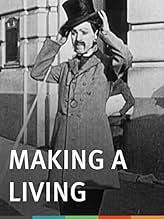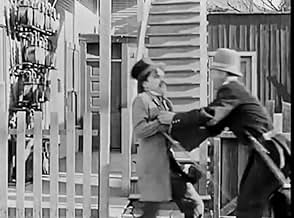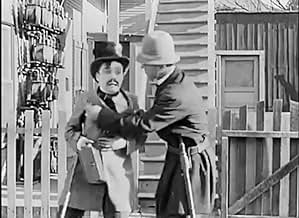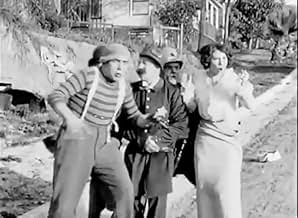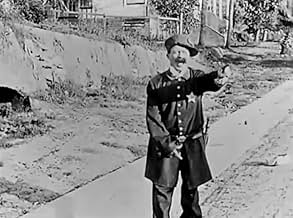Ajouter une intrigue dans votre langueAn out-of-work swindler takes a job as a reporter. After witnessing a car go over cliff, he grabs a rival reporter's camera and races to the newspaper office to enter the photo as his own. H... Tout lireAn out-of-work swindler takes a job as a reporter. After witnessing a car go over cliff, he grabs a rival reporter's camera and races to the newspaper office to enter the photo as his own. His rival is delayed when he gets caught in a woman's bedroom by her jealous husband. The s... Tout lireAn out-of-work swindler takes a job as a reporter. After witnessing a car go over cliff, he grabs a rival reporter's camera and races to the newspaper office to enter the photo as his own. His rival is delayed when he gets caught in a woman's bedroom by her jealous husband. The swindler follows the distribution of the paper containing his 'scoop' around town where he ... Tout lire
- Tough guy
- (uncredited)
- Jealous Husband's Wife
- (uncredited)
- Policeman
- (uncredited)
- …
- Mother
- (uncredited)
- Girl
- (uncredited)
- Jealous Husband
- (uncredited)
- Seated Man with Editor
- (uncredited)
- Newspaper Editor
- (uncredited)
- Wreck Bystander
- (uncredited)
- Daughter
- (uncredited)
- Cops
- (uncredited)
- Reporter
- (uncredited)
- Bald Man in Newspaper Office
- (uncredited)
- Cop at Apartment Steps
- (uncredited)
- Onlooker
- (uncredited)
Avis en vedette
Chaplin here, in his very first movie, plays a swindler masquerading as a reporter--or at least I think so. The movie moves along at such a hectic pace that it is a little confusing. Like all Keystone movies of that era, it was a silly bit of fluff. But still, it had its moments and is generally is pretty funny.
One memorable scene--memorable for its silliness--is the scene where a car gets into an accident and a reporter (Charlie? I am not sure) interviews a survivor while pinned in the wreck! That one bit of business was funny as hell. Any former present or former journalist, in particular, would appreciate it.
He did do better than 'Making a Living', his debut. Can understand why the Keystone period suffered from not being as best remembered or highly remembered than his later efforts, but they are mainly decent and important in their own right. 'Making a Living' is a long way from a career high, but does have historical significance for obvious reasons.
'Making a Living' is not as hilarious, charming or touching as his later work and a good deal of other shorts in the same period. The story is flimsy and the production values not as audacious. The comedy is mildly amusing really at best.
For someone who was new to the film industry and had literally just moved on from their stage background, 'Making a Living' is not bad at all.
While not audacious, the film hardly looks ugly, is more than competently directed and is appealingly played. Chaplin looks comfortable for so early on, though his style was still evolving and not properly found or settled yet, and shows his stage expertise while opening it up that it doesn't become stagy or repetitive shtick.
Although the humour, charm and emotion was done better and became more refined later, 'Making a Living' does have moments where it is humorous, sweet and easy to like, though the emotion is not quite there. It moves quickly and doesn't feel too long or short.
In conclusion, interesting and worthwhile but not one that makes one leap out of their chair. 6/10 Bethany Cox
This is a good example of the one- or two-reel slapstick comedies which constituted a large part of American film production at the time. While there is a story which keeps the viewer's interest, it is mainly an opportunity to accumulate as many visual gags as possible. Only four inter-titles are used in the film and they are not even really necessary. Although the filming consists mostly of wide shots and three quarter shots, always with a static camera, the editing gives a very dynamic progression of the action, with a systematic use of cross- cutting. The fact that it is mostly filmed on location in the streets of Los Angeles and in the office of the L.A. Times gives it authenticity and adds now a historical interest with views of the city and of different parts of a newspaper office in 1914, notably shots of a Linotype used for the composition of the newspaper.
http://a-cinema-history.blogspot.be/2013/09/
This is a Keystone short, so there is quite a bit of slapstick humor. Perhaps it's due to this movie being over 90 years old when I saw this, but I could not tell what exactly happened between Chaplin and the reporter (played by director Henry Lehrman). There are a few interesting parts.
If you are a fan of Chaplin and can't get enough of his work or a fan of silent slapstick comedies, this might be worth a look. Then again, it's only about 8 or 9 minutes long, so if you don't like it, you haven't wasted much of your time.
Le saviez-vous
- AnecdotesFilm debut of Charles Chaplin. NOTE: One of the few films in those early years in which he does not play the Tramp.
- ConnexionsFeatured in Hollywood and the Stars: The Funny Men: Part 1 (1963)
Meilleurs choix
Détails
- Durée
- 11m
- Couleur
- Mixage
- Rapport de forme
- 1.33 : 1

